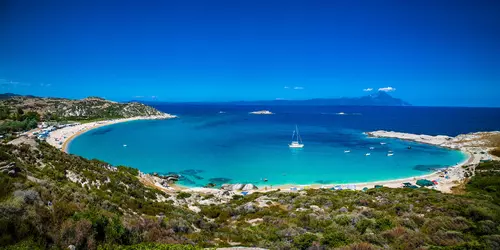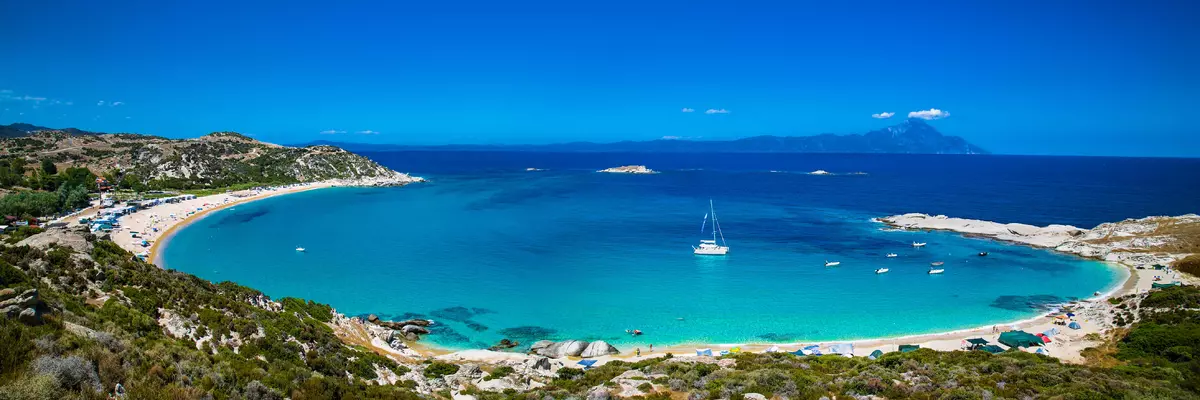Climate Table Chalkidiki
Jan | Feb | Mar | Apr | May | Jun | Jul | Aug | Sep | Oct | Nov | Dec | |
|---|---|---|---|---|---|---|---|---|---|---|---|---|
| Max. Temperature | 9° | 12° | 14° | 20° | 25° | 29° | 32° | 32° | 28° | 22° | 16° | 11° |
| Min. Temperature | 2° | 3° | 5° | 10° | 14° | 18° | 21° | 21° | 17° | 13° | 9° | 4° |
| Sun Hours | 4 | 5 | 6 | 8 | 7 | 10 | 12 | 11 | 8 | 6 | 4 | 4 |
| Water Temperature | 12° | 12° | 13° | 14° | 18° | 22° | 24° | 25° | 23° | 20° | 16° | 14° |
| Rain Days | 6 | 6 | 7 | 7 | 6 | 6 | 4 | 3 | 4 | 6 | 7 | 8 |
The climate year of Chalkidiki
The three finger-like headlands of Chalkidiki, Kassandra, Sithonia and Athos, jut into the Aegean Sea like a trident. Kassandra is dominated by agriculture and tourism. The beautiful forests on Kassandra have been decimated by forest fires. The coastal regions consist of extensive fine sandy beaches interrupted by rocky coastal stretches. The second finger, Sithonia, in contrast to Kassandra, is more mountainous and has mostly steep coasts, but has many bays, some of which are inaccessible and secluded. At the southwestern tip of the island is Porto Koufo, a large natural harbor. The third finger of the trident is Athos, a mountainous, forested part of the island, where the highest mountain of Chalkidiki is located, Mount Athos with a height of 2033m above sea level.
General information about Chalkidiki
Athos is home to the autonomous monastic republic inhabited exclusively by Orthodox monks. Entering Athos is allowed only to men who have previously obtained a visa. Women have generally been prohibited from entering for more than 900 years. Even ships or boats carrying women are only allowed to approach the coast of Athos at a distance of several kilometers. Other sights in Chalkidiki are the fortress of Rentina, the temple of Ammon Zeus at Kallithea, the ancient Olynthos or Stageira, the birthplace of Aristotle.
Tourism Halkidiki
If you want to visit Chalkidiki, you are well advised to visit the peninsula in the months of April to September. Then the temperatures rise from a light 20 degrees Celsius in April to a hot 28 degrees Celsius in September, while in October the average is a maximum of 22 degrees Celsius. In July and August, temperatures can rise to 40 degrees Celsius almost everywhere in Greece. Water temperatures are quite frosty in April/May at just 14 degrees Celsius, but then quickly rise to 25 degrees Celsius in the period July to September. So you can already orientate yourself on the temperatures and if you like hiking and are not a permanent swimmer, you will prefer the spring months. The mixed forest regions around the second highest mountain, the Cholomondas, are especially suitable for hiking. The beach regions are also good for hiking, especially when the so-called prodromi, light north winds, blow over the country at the end of May and beginning of June. These are replaced by the Meltemi, a strong north wind. These winds soften the heat and any outdoor activity becomes more bearable. Besides its positive sides, the Meltemi also has negative sides. On the one hand, it reduces humidity, but with its strong gusts it can also cause damage. This wind is perceived as a pleasant cool breeze and it always brings a serene weather and a clear view.


